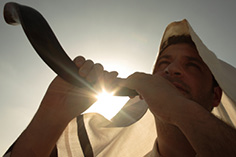 In September the Jews celebrate the New Year's Day "Rosh Hashanah", which means "head of the year" in Hebrew. It is part of the tradition of the Jews that they eat a piece of a fish's head, symbolic of the head of the year, and greet each other with “Leschana towa”, which means “Have a good year!”. According to tradition, there is a connection between the feast day of Rosh Hashanah and the sixth day of creation week, on which God created man.
In September the Jews celebrate the New Year's Day "Rosh Hashanah", which means "head of the year" in Hebrew. It is part of the tradition of the Jews that they eat a piece of a fish's head, symbolic of the head of the year, and greet each other with “Leschana towa”, which means “Have a good year!”. According to tradition, there is a connection between the feast day of Rosh Hashanah and the sixth day of creation week, on which God created man.
In the Hebrew text of the 3. Book of Moses 23,24 the day is given as “Sikron Terua”, which means “Memorial Day with Trumpet Bubbles”. This is why this feast day is called "Trumpet Day" in German.
Many rabbis teach that at Rosh Hashanah a shofar should be blasted at least 100 times, including a series of 30 painting to signal hope for the coming of the Messiah. According to the Jewish sources, there are three types of beeps that were blown on that day:
Ancient Israel originally used ram horns for their trumpets. But these became after some time, as we did 4. Learned Moses 10, replaced by trumpets (trumpets) made of silver. The use of trumpets is mentioned 72 times in the Old Testament.
The trumpets were blown to alert in case of danger, to summon the people to a festive assembly to announce announcements, and as a call to worship. In times of war trombones were used to prepare the soldiers for their mission and then give the signal for combat use. Trumpets also announced the arrival of the king.
At the present time, some Christians celebrate the Trumpet Day as a feast day with a worship service and associate it with reference to future events, to Jesus' second coming or the rapture of the church.
Jesus is the lens through which we can properly interpret the whole Bible. We now understand the Old Testament (which includes the Old Covenant) through the lens of the New Testament (with the New Covenant which Jesus Christ fully fulfilled). If we proceed in reverse order, incorrect conclusions will lead us to believe that the New Covenant will not begin until the Second Coming of Jesus. This assumption is a fundamental mistake. Some believe that we are in a period of transition between the old and new covenants and that we are therefore obliged to keep the Hebrew feast days.
The old covenant was temporary and that includes the day of trumpets. “By saying: a new covenant, he made the first an old one. But what grows old and is old is near the end »(Hebrews 8,17). It was used to announce the coming Messiah to the people. The blowing of the trumpets on Rosh Hashanah not only signals the beginning of the annual festival calendar in Israel, but also proclaims the message of this festival day: "Our King is coming!"
The feasts of Israel are primarily associated with the harvest. Immediately before the first grain festival, the “Feast of the Sheaf of First Fruits”, the “Passover” and the “Feast of Unleavened Bread” took place. Fifty days later, the Israelites celebrated the feast of the wheat harvest, the “Feast of the Weeks” (Pentecost) and in autumn the great harvest festival, the “Feast of Tabernacles”. In addition, the festivals have a profound spiritual and prophetic significance.
For me, the most important part of the day of trumpets is how it points to Jesus and how Jesus fulfilled all of these when he came first. Jesus fulfilled the day of trumpets through his incarnation, his work of atonement, his death and his resurrection. Through these "events in Christ's life" God not only fulfilled his covenant with Israel (the old covenant), but changed all time forever. Jesus is the head of the year - the head, the Lord of all time, especially because he created the time. «He (Jesus) is the image of the invisible God, the firstborn before all creation. For in him everything is created that is in heaven and on earth, the visible and the invisible, be it thrones or rulers or powers or authorities; everything is created through him and for him. And he is above all, and everything consists in him. And he is the head of the body, namely the church. He is the beginning, the firstborn from the dead, that he may be first in everything. For it pleased God to let all abundance dwell in him and through him to reconcile everything to him, be it on earth or in heaven, by making peace through his blood on the cross »(Colossians 1,15-20).
Jesus prevailed where the first Adam failed and he is the last Adam. Jesus is our Passover lamb, our unleavened bread and our reconciliation. He is the one (and only) who removed our sins. Jesus is our Sabbath in which we find rest from sin.
As a lord of all time he now lives in you and you in him. The whole time you experience is sacred because you live the new life of Jesus Christ that you have in communion with him. Jesus, is your Redeemer, Savior, Savior, King and Lord. He has let the trumpet sound once and for all!
by Joseph Tkach
This website contains a diverse selection of Christian literature in German. Translation of the website by Google Translate.